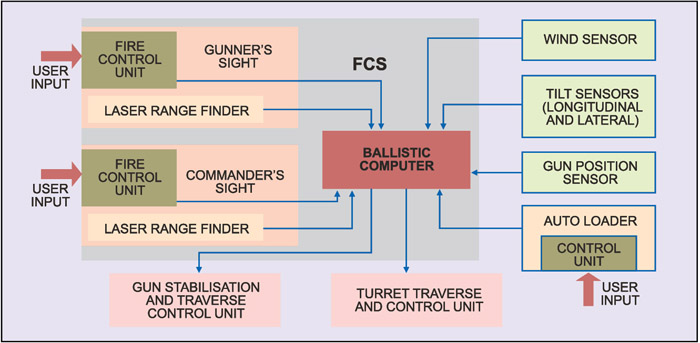The commander’s and gunner’s sights are almost equally capable and independent. The tank commander’s cumbersome opto-mechanical sights of the past have been replaced by a stabilised panoramic sight for day and night observation. Commanded through a joystick, these panoramic sights can rotate 360°. The gunner’s sight is also night-imaging capable but not panoramic. The gunner’s sight can be enslaved to the commander’s sight by the commander to see what the gunner sees. These sights find the range, speed and the bearing of a target!

With an embedded laser range finder (LRF) present in the sights, the ballistic computer gets the range of the target. The LFR flashes a narrow pulse-coded IR laser beam for a microsecond on the target area covered by the crosshairs. With laser sensors associated with the LRF, the reflected laser beam from the target is sensed. The time duration between the flashing and sensing gives the round-trip time between the tank and target. From this the ballistic computer calculates the range. The typical maximum range of laser rangefinders is 10 kilometres with an error of 10 to 20 metres at the extremities of the range.
Similarly, for a moving target, the gunner has to keep the crosshairs on the target for a second or two. During this time period, the computer flashes the LRF on the target repeatedly and extrapolates the target’s course. Now the ballistic computer has the data regarding the target’s range, speed and angle.
Sensors. Using wind sensors situated on the top of the turrets, the ballistic computer measures the crosswind speed. Using pendulum static cantilever sensors located at the centre of the turret roof, the ballistic computer calculates how much the tank is tilted due to uneven ground.
Similarly, the ballistic computer takes the speed of the tank and its course from a system called inertial navigation system (INS). (This INS is a navigation system that helps ships, aircraft and missiles to find their position in the open water and airspace, respectively. But a tank getting them is one of the strangest aspects of battle dynamics.) From the gunner’s console, the gunner has to manually input the data regarding the ammunition type and some miscellaneous data.
Additional functions of FCS
The FCS has some additional functions. For instance, FCS lays and stabilises the gun and produces symbology for the gunner/commander.
Laying the gun. From the data derived from the sensors and sights, the firing solution is derived in no time. Accordingly, the ballistic computer actuates amplidynes that move the turret in the required position. Similarly, the gun is also actuated through the amplidynes. A constant feedback is maintained to ensure that the turret and gun are moved according to the desired angles.
If the tank is moving fast and the gun is kept at the required angle rigidly, even a slight bump on the road can take the gun off the correct angle. If at that particular instant a shot is fired, even a slight bump will reduce the accuracy. So the ballistic computer holds the gun loosely on the target through stabilisation. To sense the tank’s movements, accelerometers are used as sensors that give an electrical output whenever the tank jerks. Immediately the FCS correspondingly controls the amplidynes and maintains the gun in the required orientation—all in just a fraction of second.
Symbology. Apart from these sensing and controlling operations, the ballistic computer generates symbologies on the display regarding various parameters, like range of the target. By displaying a ready symbology on the sight, it also indicates to the gunner that he can shoot.
Autoloader and shell loading. The firing solution has been derived, the gun is laid, what about the ammunition? Generally, it will be loaded even before deriving the firing solution. Who does it? Western tanks require a soldier known as loader who, under the command of the gunner, picks up the appropriate shell from ammunition rack and loads it in the gun. A slight mistiming can result in amputation for him.
The Soviet Union/Russian-origin tanks use an important system called autoloader. The autoloader is a separate system but loosely interacts with the FCS. The autoloader selects the shell according to the gunner’s command and loads it in the gun. During combat, different types of shells are required to tackle various situations. For this, the gunner inputs the required shell type in his console and the autoloader loads accordingly. The FCS checks whether the autoloader has loaded the shell into the gun or not.
Engagement sequence
In a typical combat, the tank commander (with his panaromic sight) searches for a suitable target, detects it and presses a switch called align switch. The FCS slews the turret to face the target. The gunner then takes over the engagement of the target. The gunner aligns the reticle on the target and then the FCS takes over the engagement from him. The FCS starts performing the sequence of events from ranging and tachometric process (detecting the speed of the target), lays the gun and when all are set, the gunner can fire the gun.





